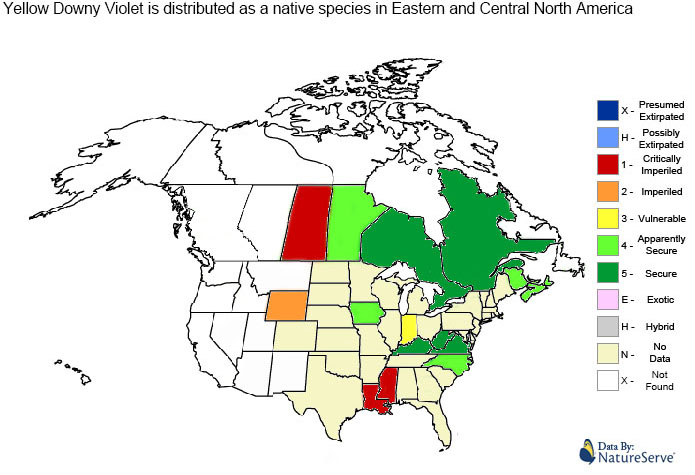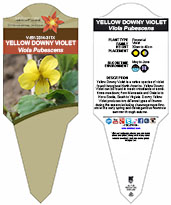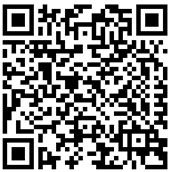

| Plant Name | Yellow Downy Violet | |
| Scientific Name | Viola Pubescens | |
| Family | Violet | |
| Plant Type | Perennial | |
| Start of Blooming Season | May | |
| End of Blooming Season | June |

| Soil Conditions | |
| Soil Moisture | |
| Sunlight | |
| Notes: |

Yellow Downy Violet grows 15cm to 40cm tall with soft woolly hairs covering the plant stems. The leaves of yellow downy violet are cordate shaped with a crenate margin and are approximately 4cm to 10cm long and 4cm to 13cm wide; with cross-venulate venation. Yellow Downy Violet has bright yellow flowers, veined with purple toward the throat, that are 15mm to 25mm wide with five petals. Each flower contains five sepals, five stamens, and 1 pistil. Each year the yellow downy violet produces one, woolly haired, seed capsule approximately 10mm to 12mm long.

| Plant Height | 15cm to 40cm |
| Habitat | Dry forests and meadows |
| Leaves | Cordate 4cm to 10cm long |
| Leaf Margin | Crenate |
| Leaf Venation | Cross-venulate |
| Stems | Hairy stems |
| Flowering Season | May to June |
| Flower Type | Bilaterally Symmetrical |
| Flower Colour | Yellow |
| Pollination | Bees, Insects |
| Flower Gender | Flowers are hermaphrodite and the plants are self-fertile |
| Fruit | Small capsule 10mm to 12mm long |
| USDA Zone | 4A (-31°C to -34°C) cold weather limit |

No known health risks have been associated with yellow downy violet. However ingestion of naturally occurring plants without proper identification is not recommended.

 |
-Click here- or on the thumbnail image to see an artist rendering, from The United States Department of Agriculture, of yellow downy violet (This image will open in a new browser tab) |

Yellow Downy Violet can be referenced in certain current and historical texts under the following four names: Downy Yellow Violet can be translated into the following select languages: |
|||||||||||||
| Arabic | الأصفر البنفسجي ناعم | Bulgarian | жълто копринено виолетово | Chinese (Sim) | 黄色柔和的紫罗兰 | ||||||||
| Croatian | žuti ljubičasti ljubičasti | Czech | žlutá pinková fialová | Danish | |||||||||
| Dutch | Esperanto | flava ruĝa violo | Estonian | kollane väike violetne | |||||||||
| Finnish | keltainen aallotettu violetti | French | violet duvet jaune | German | gelb flaumig violett | ||||||||
| Greek | κίτρινο μαύρο μωβ | Hebrew | צהוב סגול | Hungarian | sárga lila ibolya | ||||||||
| Italian | giallo lanuginoso viola | Japanese | 黄色いダウンニーバイオレット | Korean | 노란 솜털 같은 보라색 | ||||||||
| Punjabi | ਪੀਲੇ ਰੰਗ ਦੀ ਵੇਈਓਟ | Lithuanian | geltona rausva violetinė | Norwegian | gul nedeformet fiolett | ||||||||
| Persian | بنفش نازک زرد | Polish | żółty puchaty fiołek | Portuguese | violeta amarelo suave | ||||||||
| Romanian | Russian | желтый пушистый фиолетовый | Slovak | žltá fialová | |||||||||
| Spanish | amarillo violeta suave | Swedish | Tagalog | dilaw na kulay-lila | |||||||||
| Turkish | sarı tüylü menekşe | Ukrainian | жовта пухна фіолетова | Vietnamese | màu vàng tím | ||||||||

| The information provided in this conservation assessment has been provided by the Natureserve Database in conjuction with various federal, provincial, state, county, district, regional, and municipal governments as well as public and private conservation authorities. Information in this section is accurate from the last time this article was updated. |
|
 |
Yellow Downy Violet is considered to be a secure native species in North America. |

 |

 |
The MIROFOSS database offers free printable garden tags for personal and non-profit use. These tags can be used to properly identify plant samples in a garden. Click on the tags shown on the the screen or -click here- to download a full size jpeg image for a yellow downy violet identification tag; which can be printed on paper or used with a plastic laser printer. |
 |
What's this? What can I do with it? |

| Description | Dickinson, T.; Metsger, D.; Bull, J.; & Dickinson, R. (2004) ROM Field Guide to Wildflowers of Ontario, Royal Ontario Museum, Toronto:McClelland and Stewart Ltd. |
| Description | Kartesz, J.T. 1994. A synonymized checklist of the vascular flora of the United States, Canada, and Greenland. 2nd edition. 2 vols. Timber Press, Portland, OR. |
| Description | Gleason, H.A.; Cronquist, A. (1991). Manual of the Vascular Plants of Northeastern United States and Adjacent Canada. Bronx, NY: The New York Botanical Garden Press. p. 162. ISBN 978-0893273651. |
| Image Rendering | USDA-NRCS PLANTS Database / USDA NRCS. Wetland flora: Field office illustrated guide to plant species. USDA Natural Resources Conservation Service. |
| Environment | National Audubon Society. Field Guide To Wildflowers (Eastern Region): Alfred A. Knopf. ISBN 0-375-40232-2 |
| Physical Identification | National Audubon Society. Field Guide To Wildflowers (Eastern Region): Alfred A. Knopf. ISBN 0-375-40232-2 |
| April 22, 2018 | The last time this page was updated |
| ©2021 MIROFOSS™ Foundation | |
 |